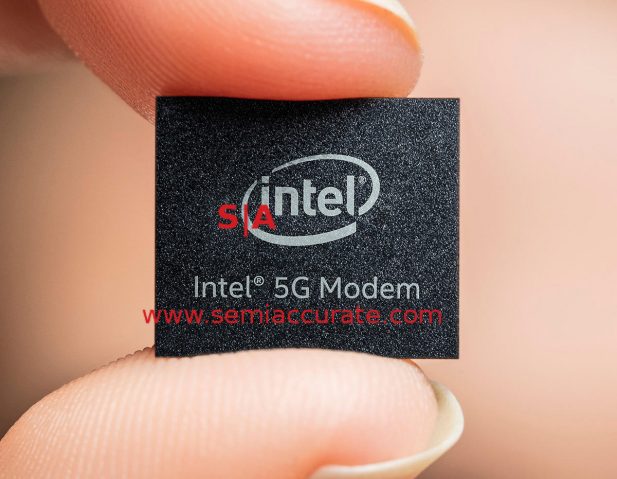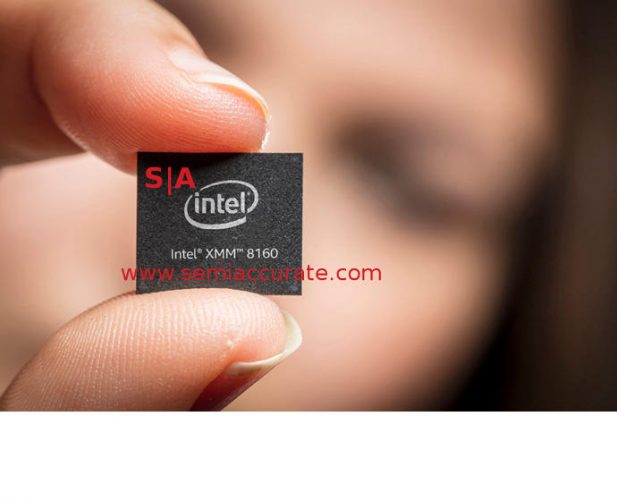 Intel’s 5G ‘strategy’ is becoming a farce. Today’s triumphant pull-in of the XMM8160 would make SemiAccurate laugh if it wasn’t so unethical.
Intel’s 5G ‘strategy’ is becoming a farce. Today’s triumphant pull-in of the XMM8160 would make SemiAccurate laugh if it wasn’t so unethical.
Lets start out with the facts. Intel had its 5G modem, the XMM 8060 in the works but that part is now canceled. Instead it was replaced by the new and better XMM 8160 due in the second half of 2019. Based on what Intel was saying and showing, it is hard to come up with an explanation that doesn’t include the phrases, “intentionally misleading”, “outright lying”, and euphemisms that we can’t print on this site. If this seems rather harsh, bear with me. The XMM 8160 is being spun as a great victory for Intel in the classic PR spin way.
Once upon a time, a product, the XMM 8060, was doing amazingly well and had no problems. But then along came a replacement that was doing so much better and is so far ahead of schedule that there was no need for the 8060. The new XMM 8160 makes it obsolete. This is the polite, dare we say bullshit, way of saying that the XMM 8060 was broken, would never work, and even Intel couldn’t keep up the farce any more.
The replacement, XMM 8160 is so good that Intel had to hide it from the press, no fanfare, a single press release on their website. A single friendly pre-timed article in Forbes. These are not signs of an “ahead of schedule” product, no public announcement is always indicative of a promising new technology without problems. Instead they paid “analysts” to put out a puff piece on Forbes that utterly glosses over the lack of working product to date and declares victory for Intel and Apple in 5G.
Please note that the financial ties to the analyst firm in question are not disclosed in the article or on Forbes, those ties are disclosed on the author’s site. This reads to us as damage control with hidden relationships because honest disclosure would hurt the spin. Either that or the analysts in question independently wrote up a long glowing piece and published it within seconds of the release going live on Intel’s site, make up your own mind as to which you believe.
When Intel first launched the XMM 8060, or at least tried to grab headlines about it, we didn’t mock them much. In retrospect we shouldn’t have held back. When Intel followed it up a few months later, we didn’t hold back as much. “Starting out with the fact that the Intel 8000-series 5G modem has not been shown or demonstrated anywhere, period. Their ‘release’ of the ‘product’ was accompanied by the badly photoshopped image above, Intel likely doesn’t have the silicon they are ‘releasing’ much less have it working. That said they are going to ‘show’ a ‘sneak peek’ of it at MWC, very likely without divulging what silicon is in the box.”
All of the above may not be all that damning. Sure Intel has never shown actual 5G silicon because they simply do not have it. Let us repeat that, Intel spend $200m on Olympics 5G sponsorship and didn’t have a product to show. A year later they still don’t. Intel quite literally faked the ‘chips’ because they didn’t have them. Period. I am not sure what you would call multiple press releases, briefings, and public demonstrations of chips that weren’t real but if you use a word that rhymes with ‘tied’ I wouldn’t have much objection.
Fake pic first generation
Now here is the big problem. Remember that fake ‘chip’ shot of the XMM 8060 we published, and mocked? You know the one we reprinted above? Now go look at the the new, better badly photoshopped fake image of the XMM 8160 second generation part below. It too is obviously a fake but, well, doesn’t Intel have the money or skill to NOT USE THE SAME PHOTO FOR TWO GENERATIONS OF FAKED PRODUCTS? I guess not. Sure the background image is a replaced but if you look at the fingerprints closely they are the same. You can even see where Intel photoshopped the blemish out of the 5G/XMM 8060 pic but not the 8160. If you go so far as to look at the originals, the areas we cropped match too, but I will leave that as an exercise for the readers.
Fake pic second generation
So where does that leave us? Intel has proclaimed 5G leadership for years and spent hundreds of millions of dollars to say so. They have not shown a single chip yet, anywhere, to anyone, working or not, only photoshopped fakes accompanied by analyst praise. This time around they used the same picture as the XMM 8060 and, well, repeated the process as before.
A detour into why this might be an issue. Verizon has 5G lit up on towers in Los Angeles. The general expectation is that most phone providers will have one to many phones available with 5G modems in them from MWC 2019 announcements to a general rush next summer through the holiday season. The validation process for a phone in the US is a year to two years. We have not even seen a working prototype from Intel. So let’s say that Intel has a working prototype tomorrow. How long will it take for phone makers to rush that through validation in the US? How long for full manufacture for both the modem and the phone? Shipping for sale? It begins to make you wonder why this announcement now? Why this announcement in this way right now?
Intel has never gotten a fully working modem to spec, has no 5G products, is years behind the competition and seems to be attempting to hide this fact. Meanwhile Qualcomm has functional production 5G silicon, antenna tuning hardware, envelope tracking, PMICs, and the rest that all fits in a phone form factor. And works. Well. Intel is years behind, and seems to be slipping.S|A
Charlie Demerjian
Latest posts by Charlie Demerjian (see all)
- Qualcomm Is Cheating On Their Snapdragon X Elite/Pro Benchmarks - Apr 24, 2024
- What is Qualcomm’s Purwa/X Pro SoC? - Apr 19, 2024
- Intel Announces their NXE: 5000 High NA EUV Tool - Apr 18, 2024
- AMD outs MI300 plans… sort of - Apr 11, 2024
- Qualcomm is planning a lot of Nuvia/X-Elite announcements - Mar 25, 2024

